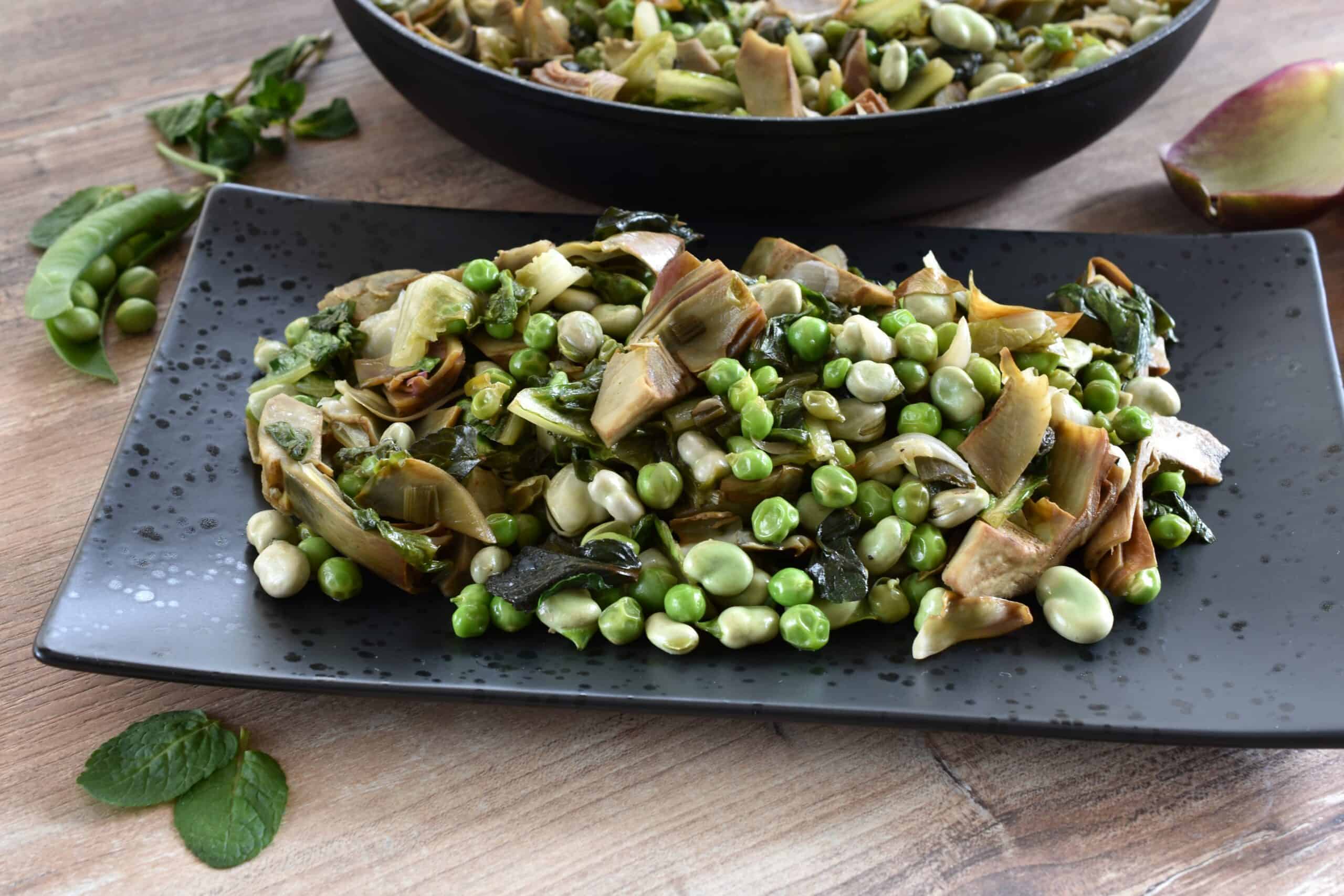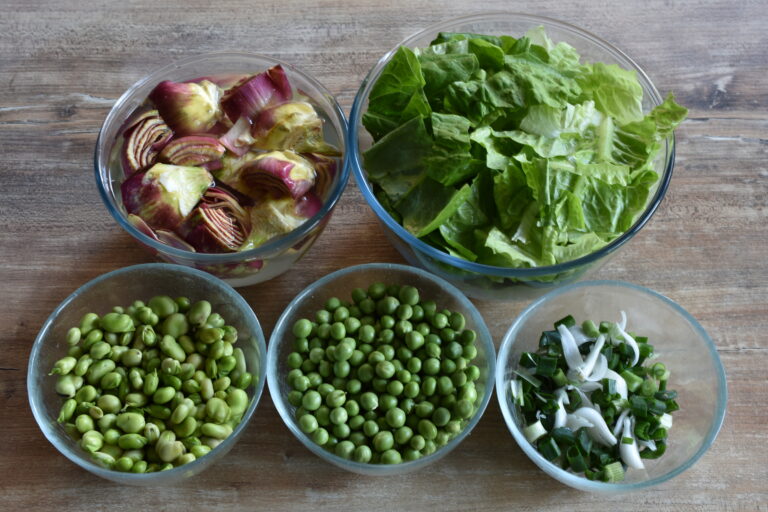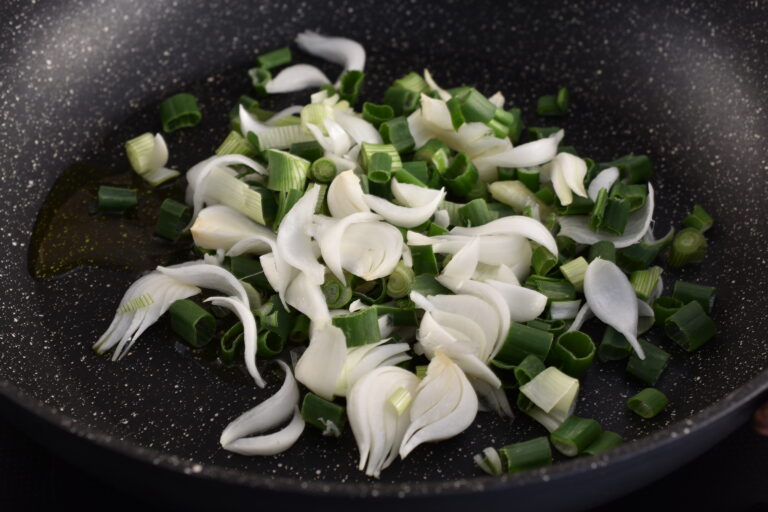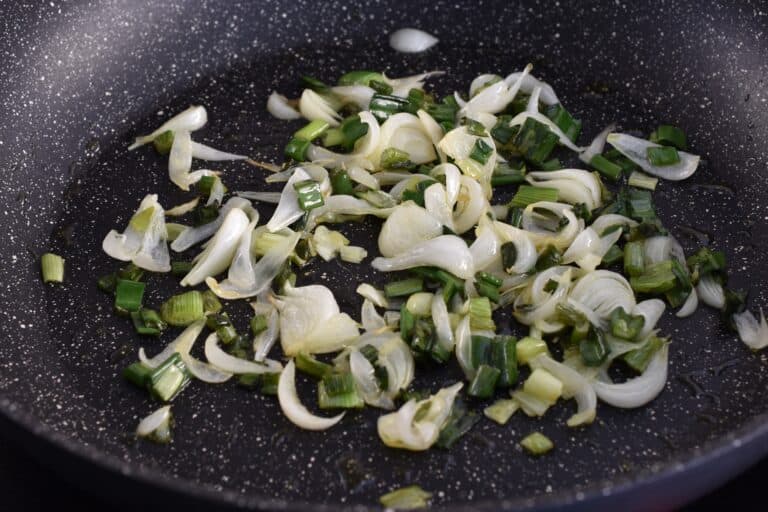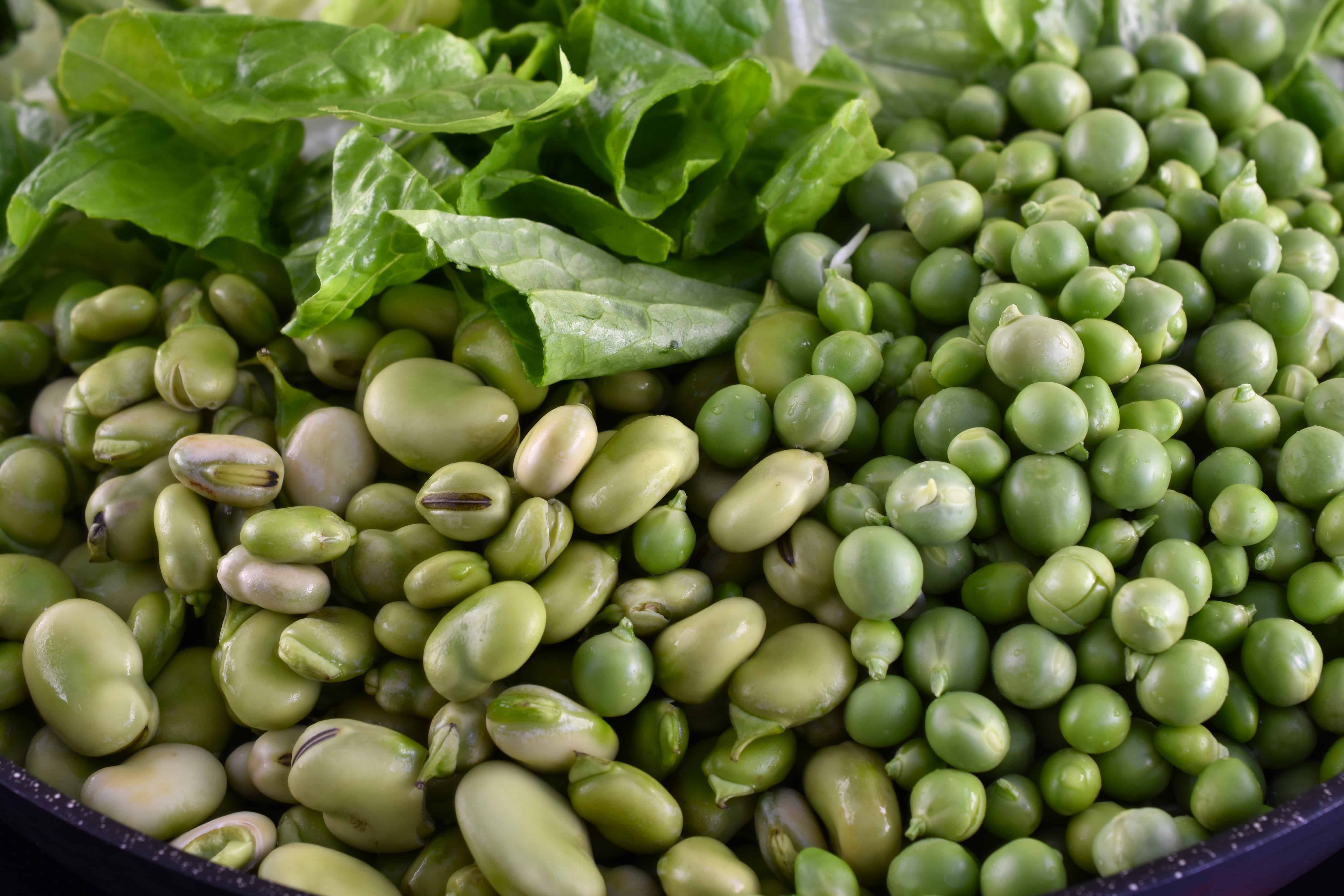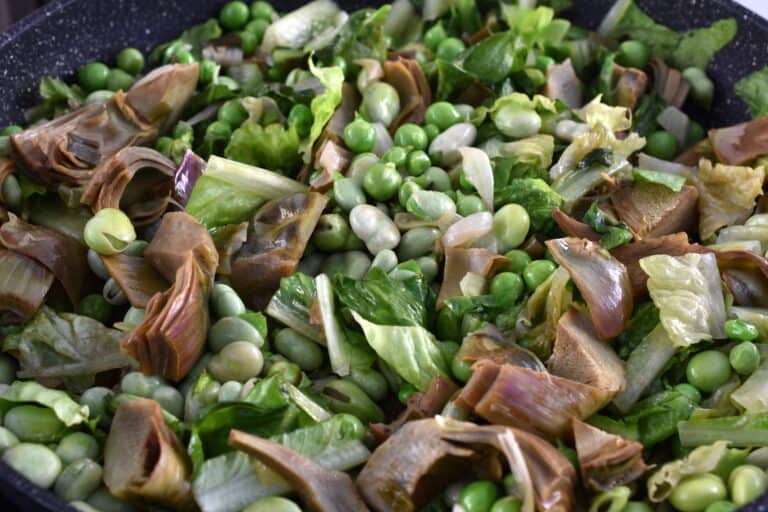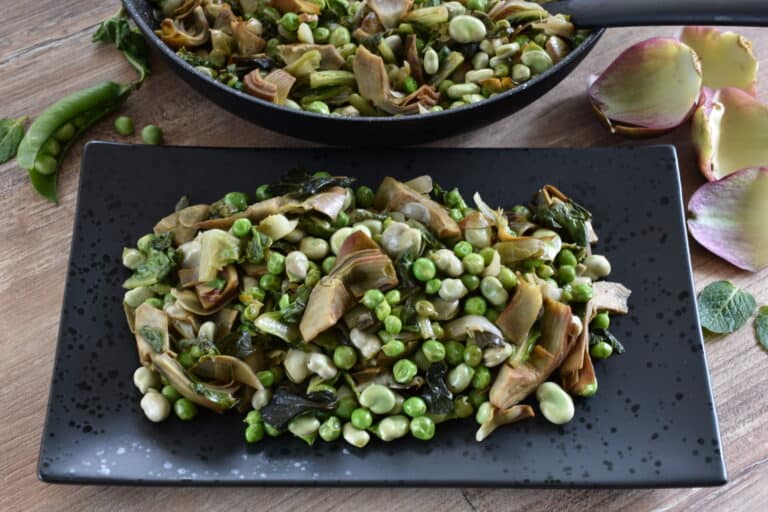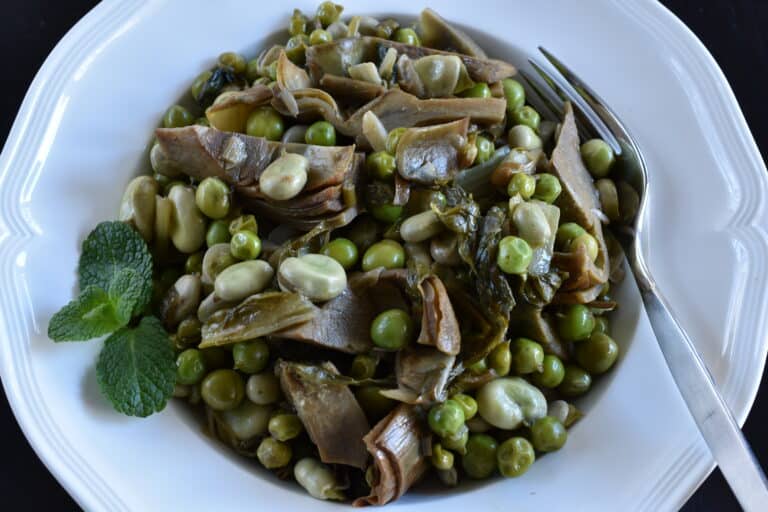Vignarola is a seasonal dish hailing from the Italian region of Lazio, which encompasses the capital city of Rome. Bursting with flavour and fresh greenness, this fresh vegetable medley is as pleasing to the eyes as it is to the tastebuds!
Vignarola is a springtime dish that consists of fresh seasonal vegetables. Roman mammole artichokes, peas, broad (fava) beans, Romaine lettuce and spring onions are the main components of an authentic vignarola. Artichokes are winter vegetables that come into season at the onset of winter and last until mid-spring. New peas and broad beans start to appear in March, along with Romaine (cos) lettuce and spring onions.
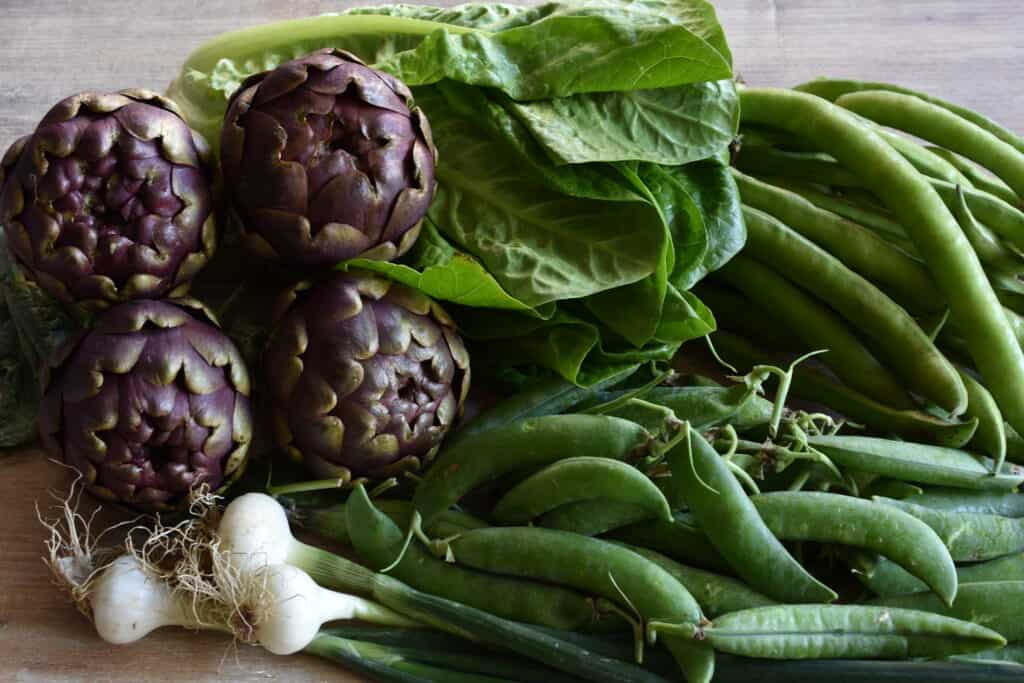
Vignarola is a celebration of spring and is the perfect dish for when the weather starts to get warmer and you want to make the most of those fresh seasonal vegetables. You can also make this dish out of season using frozen vegetables, although it’ll never be quite the same as eating a vignarola when the ingredients are in season and at their sweetest and most tender. The seasons for artichokes, broad beans, peas, Romaine lettuce and spring onions overlap, but you can normally get hold of them all between the months of March and May.
Origins of vignarola
Vignarola is an ancient, naturally vegan dish which dates back to Roman times. Some say that the name comes from the term “vignarolo”, a local Italian word used to identify the greengrocer of the era. Another hypothesis is that the ingredients used to cook this dish were collected by winemakers who gathered them on their return home back from the vineyards (vigne or vigneti in Italian), along which vegetables were cultivated. One thing is certain, its origins are deeply rooted in the traditions of the “cucina povera” of the Roman people and have been for centuries.
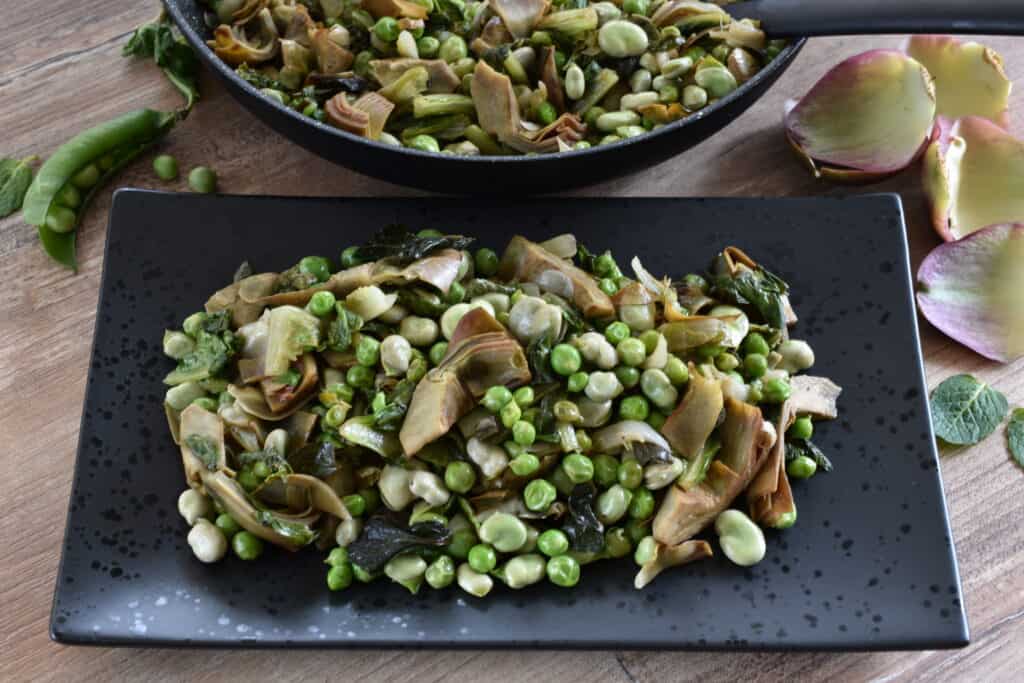
Vignarola – all about the recipe and its variations
As with all regional recipes, there are as many variations as there are chefs. What everyone in Lazio seems to agree on, though, is that the three main ingredients are artichokes, peas and broad beans, without which one couldn’t call it a vignarola. Some recipes call for white wine – others don’t. Most have Romaine lettuce, but you might find one that doesn’t. Some chefs add broth, whereas others only use salt.
In more recent times, variations have appeared featuring pieces of meat, like guanciale. Of course, we won’t be using meat, and the original version never had any meat in it.
The vegetables are slowly braised in a mix of olive oil and white wine or broth until they are glistening, tender and bursting with flavour. Some chefs swear by braising the vegetables until they are cooked through. Others say they should be sautéed just long enough for the peas and beans to soften a little, while still retaining their vibrant green colour. All the ingredients in this dish can be eaten raw, so how long you cook them for is a matter of personal taste.
How to make vignarola
Ingredients
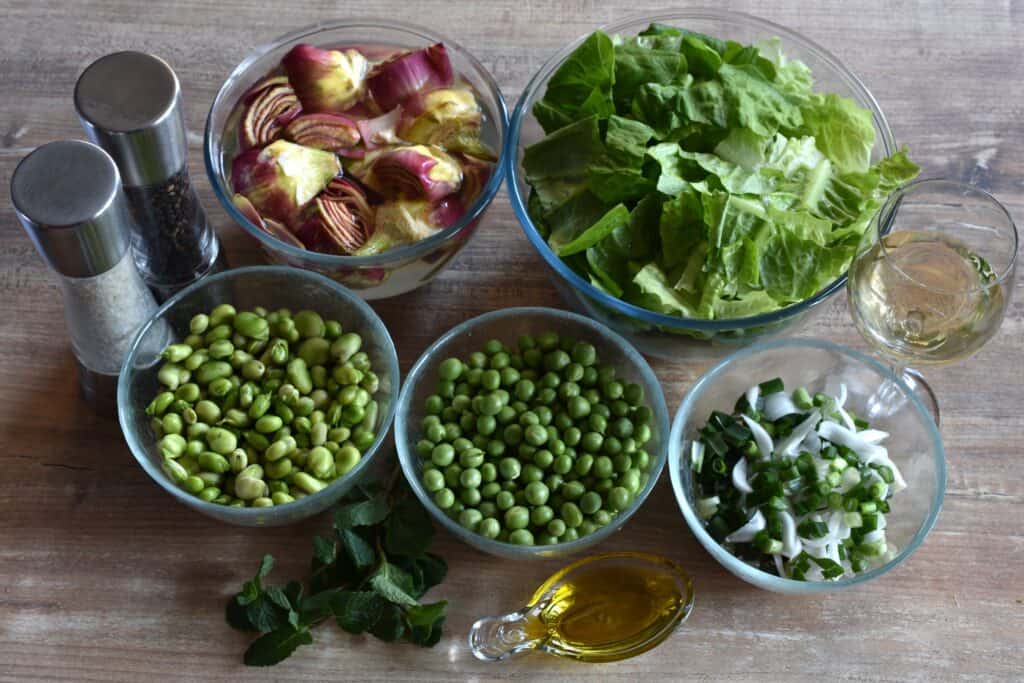
- Artichokes – In Rome, they use their own locally grown variety of artichoke called mammola or carciofo romanesco. It’s large and rounded without thorns (see photo at the top of the page). You can use any kind of artichoke for this recipe, though. Even frozen ones. I don’t recommend using artichokes in brine or oil.
- Lemon juice – Dousing the artichokes in lemon juice after you have trimmed them will stop them from turning brown.
- Broad (fava) beans – Choose young, tender beans that won’t take long to cook.
- Peas – Fresh spring peas are best, but if you can’t get hold of them, use frozen ones.
- Romaine (cos) lettuce – This can be considered optional, as not all vignarola recipes include it. If you can get hold of romaine lettuce, give it a try! Italians often cook lettuce varieties which is something we don’t really do in England and the US. You’ll be pleasantly surprised that it’s also delicious cooked.
- Extra virgin olive oil – Use a good quality oil for this recipe.
- Spring onions – The vibrant green and white of spring onions really enhances this vignarola and they are in season right now. But you can substitute them with an ordinary yellow onion if you want.
- Unrefined sea salt
- Freshly ground black pepper
- White wine – Use a dry or semi-dry white wine for this recipe.
- Water – Just enough to keep the vignarola moist. For extra flavour, you can use vegetable broth.
- Mint – In Lazio, the traditional garnish is mentuccia romana (calamint or nepitella). You could substitute it with spearmint or any other type of mint used for cooking. Alternatively, either omit the mint completely or use parsley.
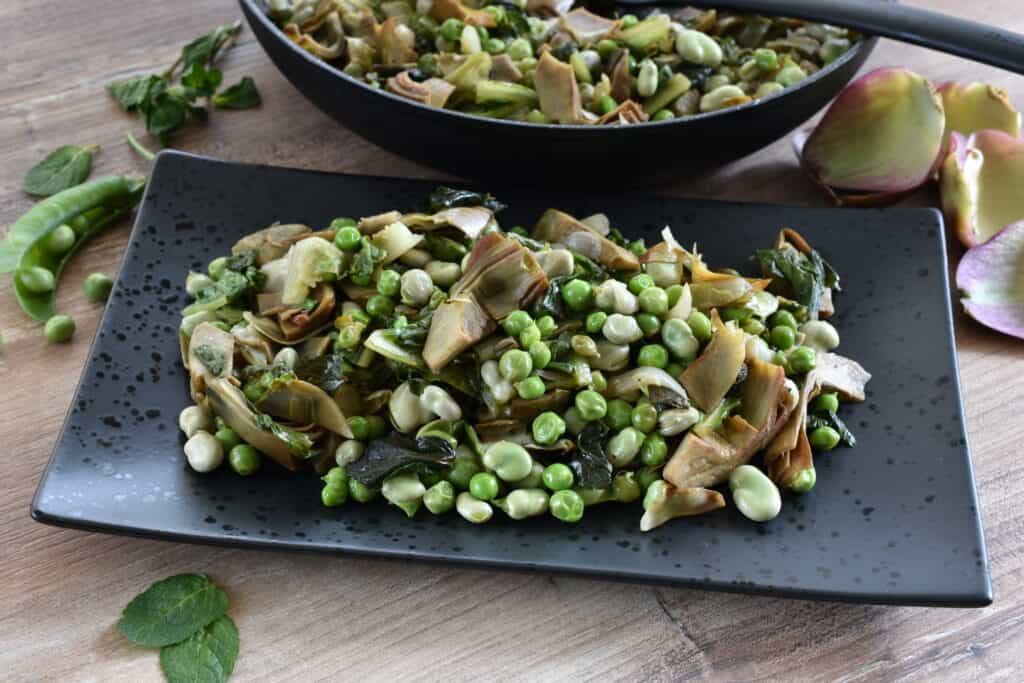
Method
For step-by-step instructions with photos, see the recipe card below.
- Prepare all the vegetables. If using fresh artichokes, trim them and cut them into quarters. Douse them in lemon juice and place them in a bowl of cold water. Shell the peas and broad (fava) beans. Trim and wash the Romaine lettuce. Slice the leaves once lengthwise through the central rib and then crosswise into medium-sized strips. Slice or chop the spring onions.
- Put the spring onions in a pan with the olive oil. Heat the oil and sweat the onions on a low heat until soft and translucent.
- Cut each artichoke quarter in half again to obtain eighths. Add the artichoke pieces to the pan and sauté them on a medium heat with the onion for a couple of minutes. Season well with salt and pepper. Turn the heat up and add the wine. Let the alcohol evaporate – this only takes a few seconds. Don’t reduce the wine by more than 25% – this is your cooking liquid.
- Add the broad beans, peas and romaine lettuce to the pan.
- Stir the vegetables, coating them all in the oil and wine, and adding a few pinches of salt as you go. Put a lid on the pan and cook on a medium heat, stirring often. You may need to add a few tablespoons of water. There should always be a little juice in the bottom of the pan.
- Cook the vegetables to your liking. This can be anytime from 5 minutes to 15 minutes. The shorter the cooking time, the more vibrantly green the vegetables will be. Cooking them for longer will result in their colours becoming duller. Cook your vignarola to your own personal taste.
- Add a little chopped mint if you wish, and correct the seasoning if necessary. When you are satisfied with the taste and consistency, transfer the vignarola to a serving dish or individual plates and garnish with a sprig of mint.
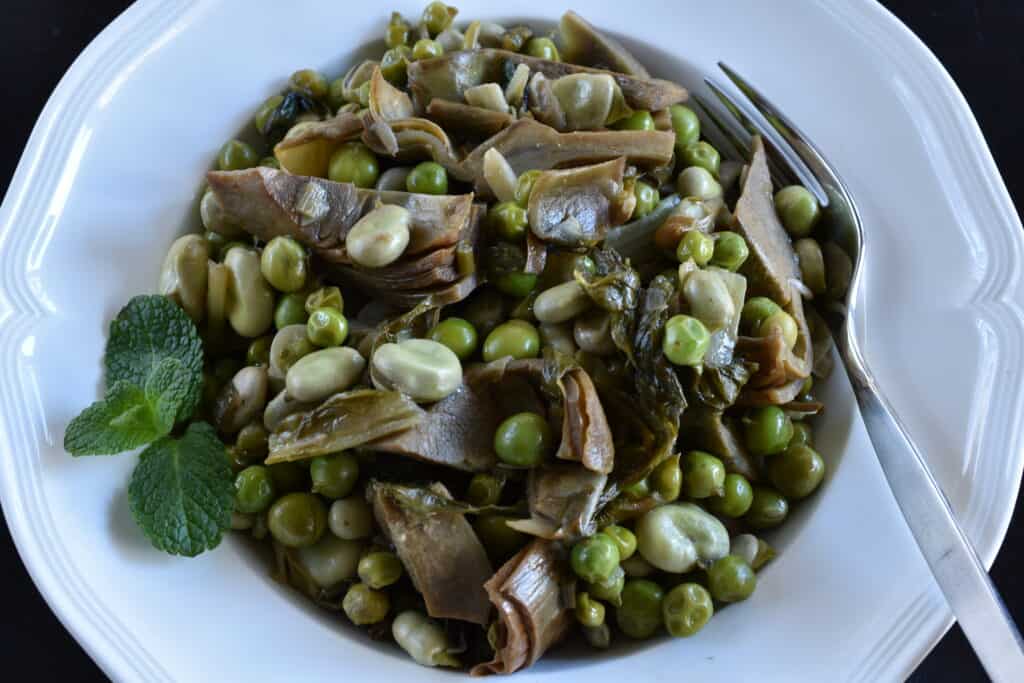
How to serve vignarola
Vignarola is packed with nutrients and high in protein thanks to the legumes and artichokes. It really is a complete meal on its own, needing nothing more than a slice of crusty bread to mop up the delicious juices.
In Rome, restaurants often serve vignarola as a side dish to accompany a main course of meat. If you’re vegan and want to serve it as a side dish, you could opt for something like a seitan-based main course or vegan sausages.
Some people serve it with pasta. Drain your pasta a couple of minutes early and finish cooking it in the pan with the vignarola juices and as much of the vegetables as you see fit.
How to store vignarola
Store any leftover vignarola in an airtight container in the fridge, where it will keep for 3 – 4 days. It also freezes well.
Vignarola is a hearty and tasty dish that celebrates the bounty of the spring season in Italy and is loved by many people in Lazio and beyond. Why not try it and find out for yourself?!
Like this recipe? Leave a comment below – I’d love to hear from you!
I hope you enjoy this vignarola recipe! If you do, would you mind giving it a star rating and leaving a comment below? It’s the best way to show your support, and it helps other readers to find my blog and recipes, too!
While you’re here on Vegan Hot Stuff, maybe you’d like to take a look at some other delicious vegan recipes…
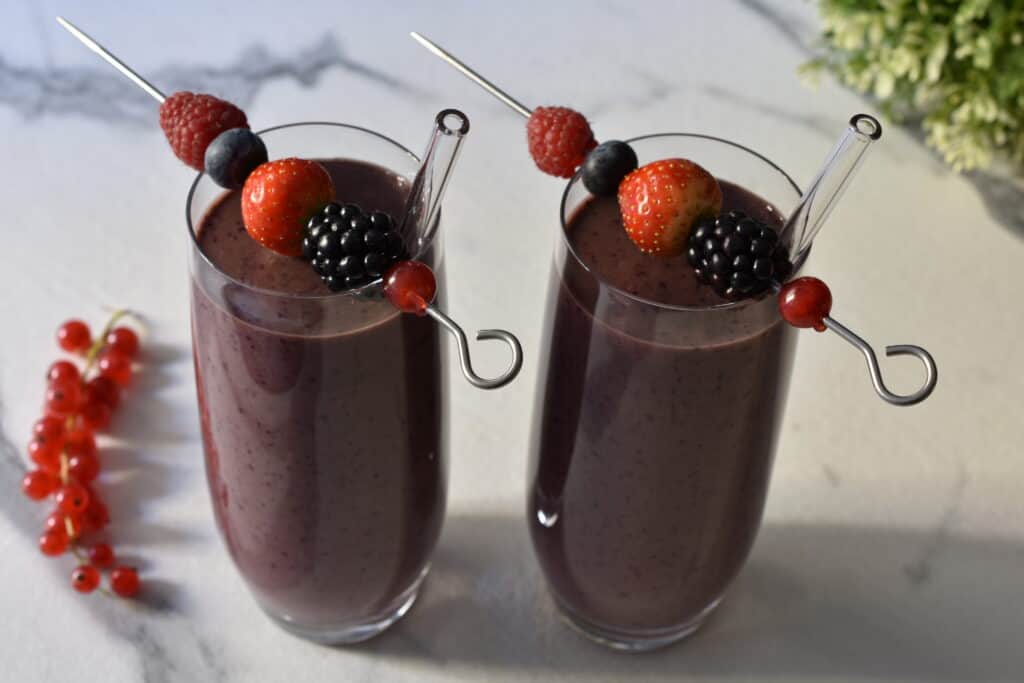
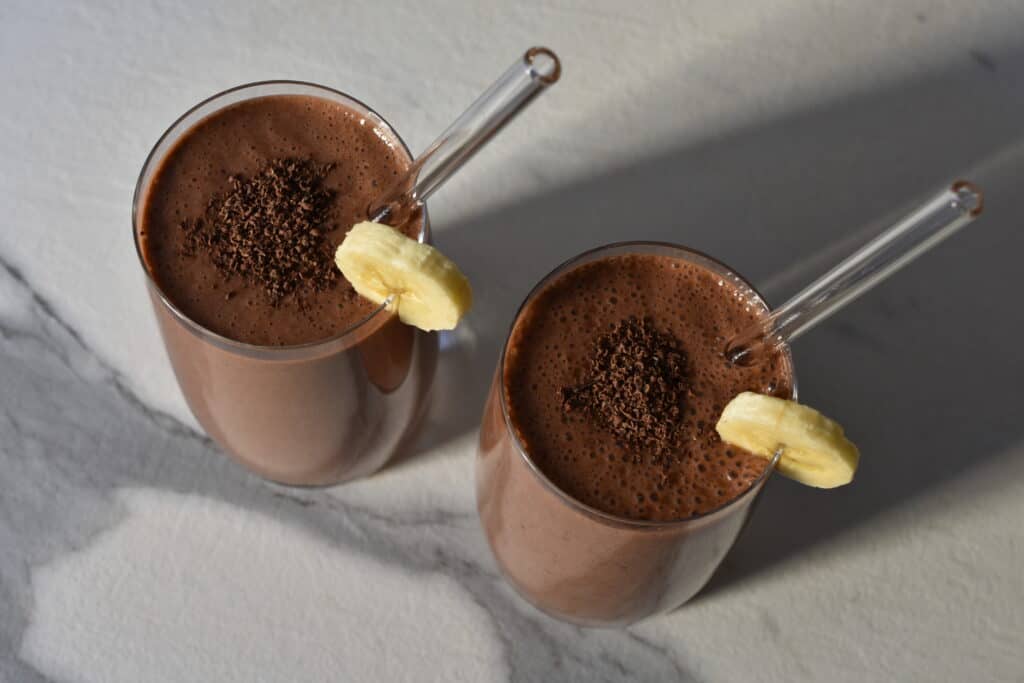
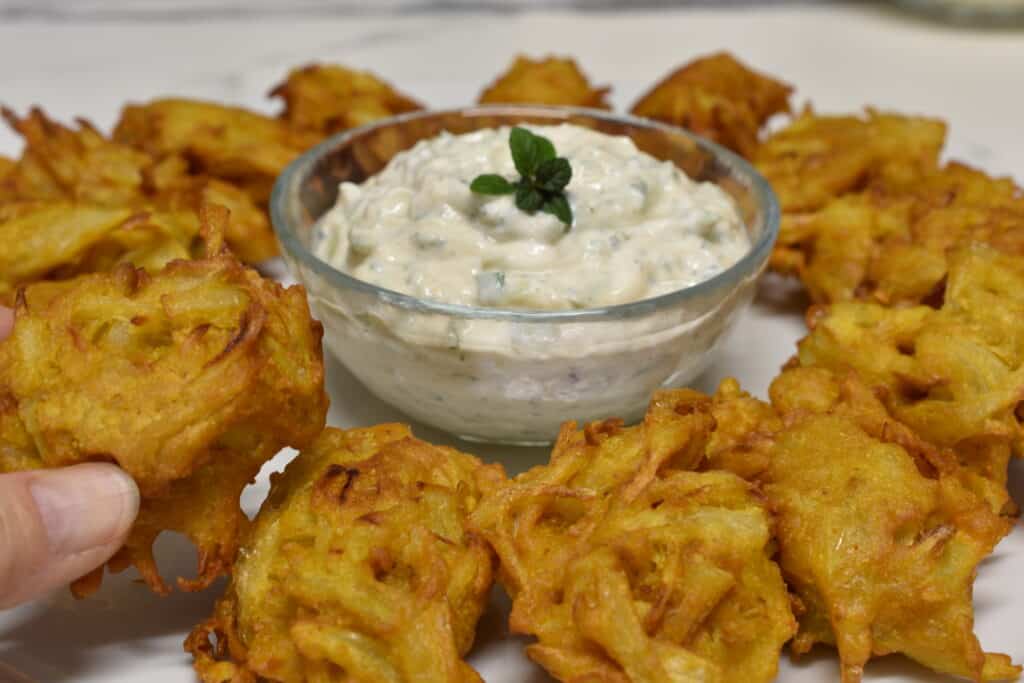
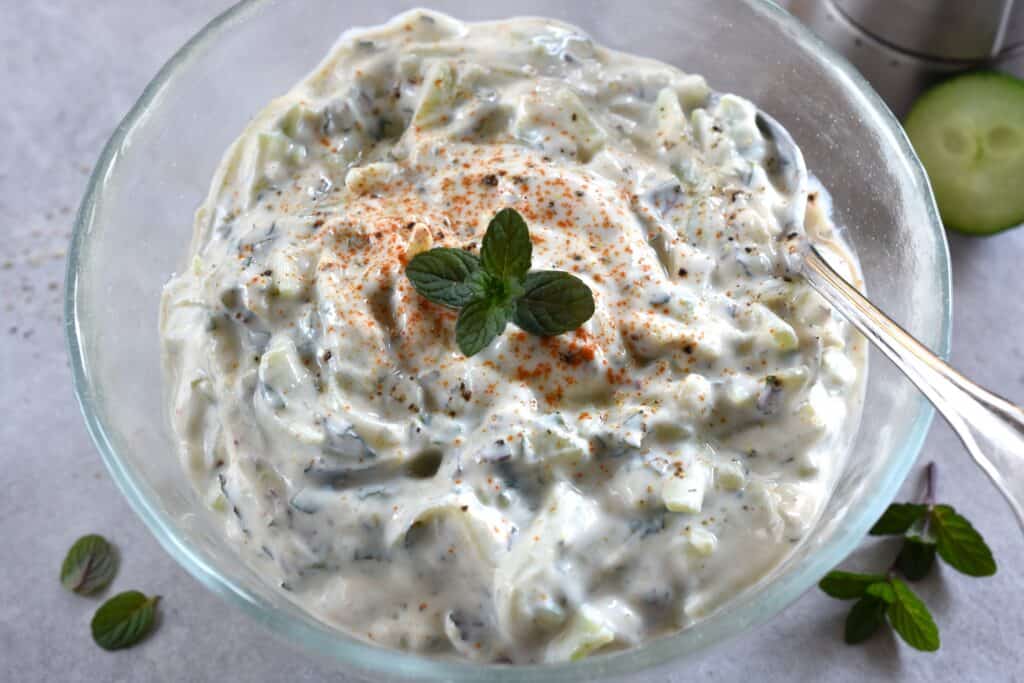
Would you like to receive my recipes as soon as I publish them? Subscribe below!


